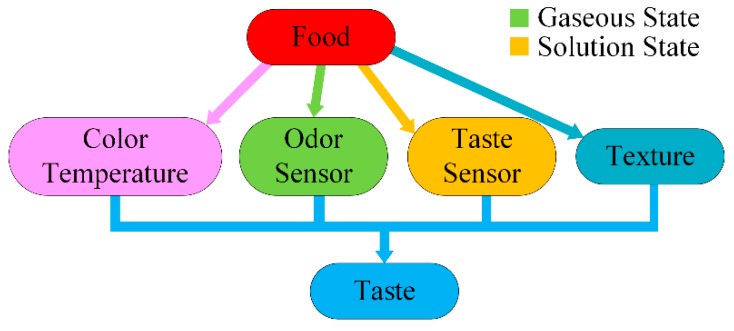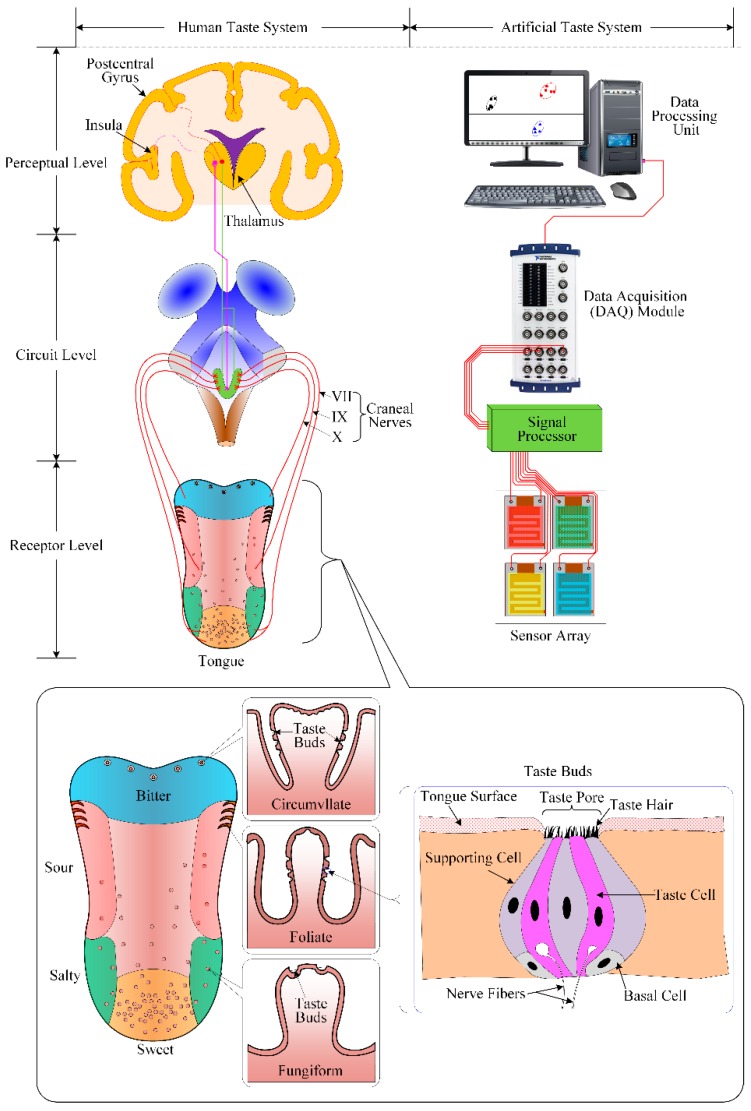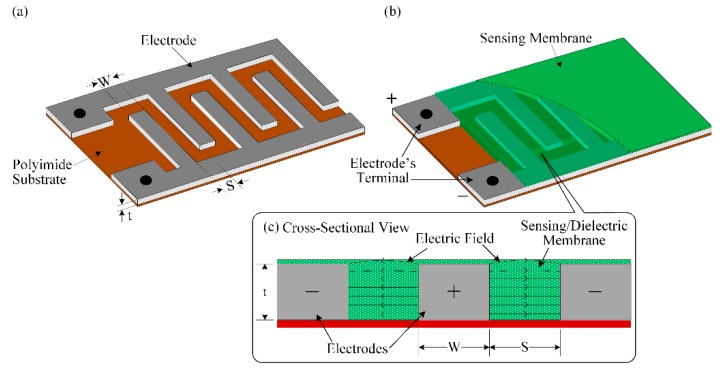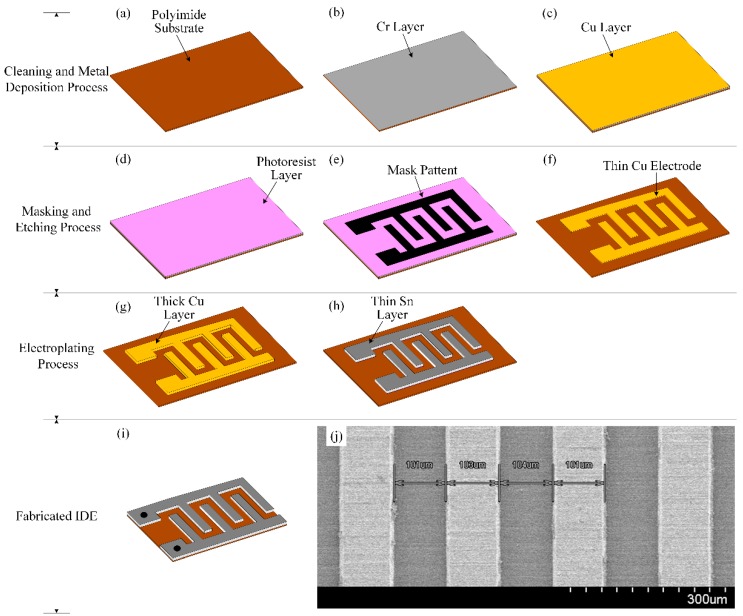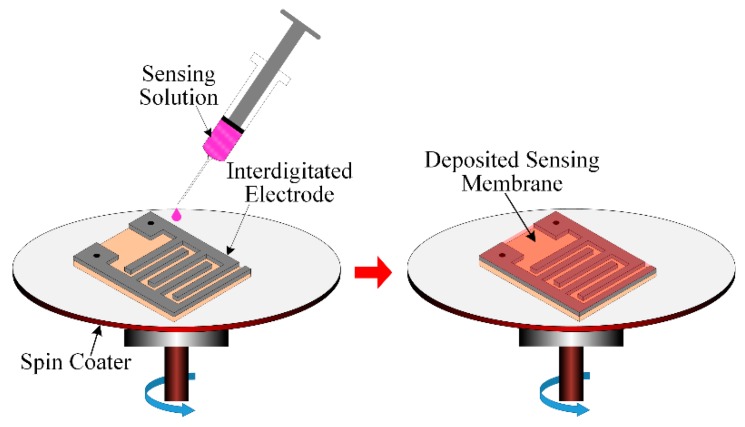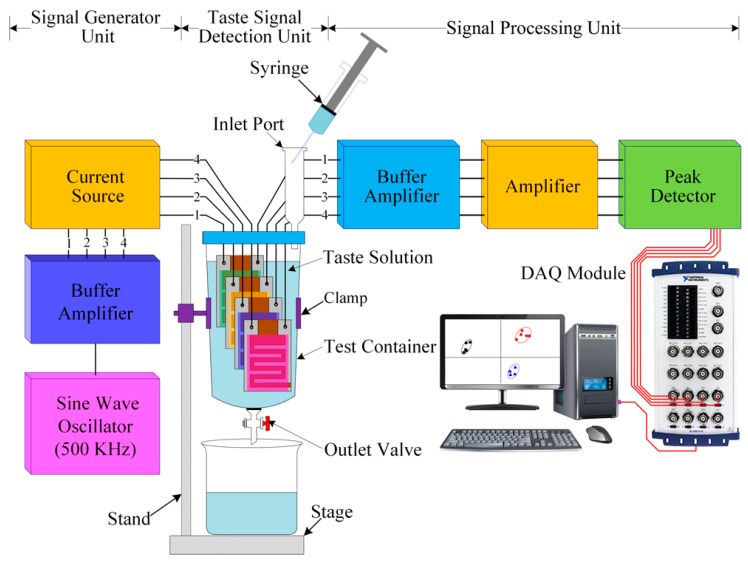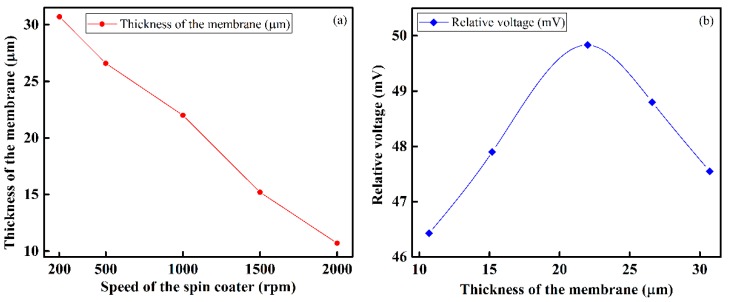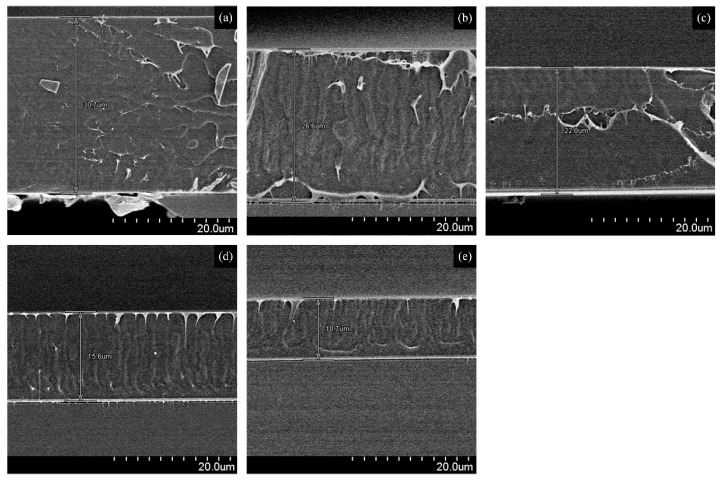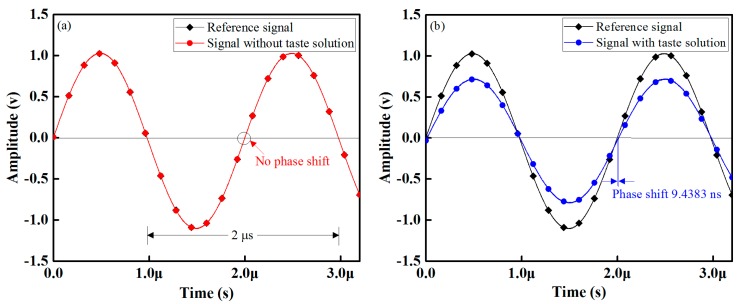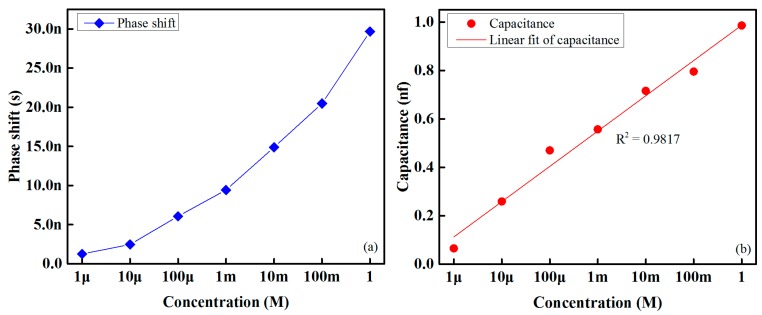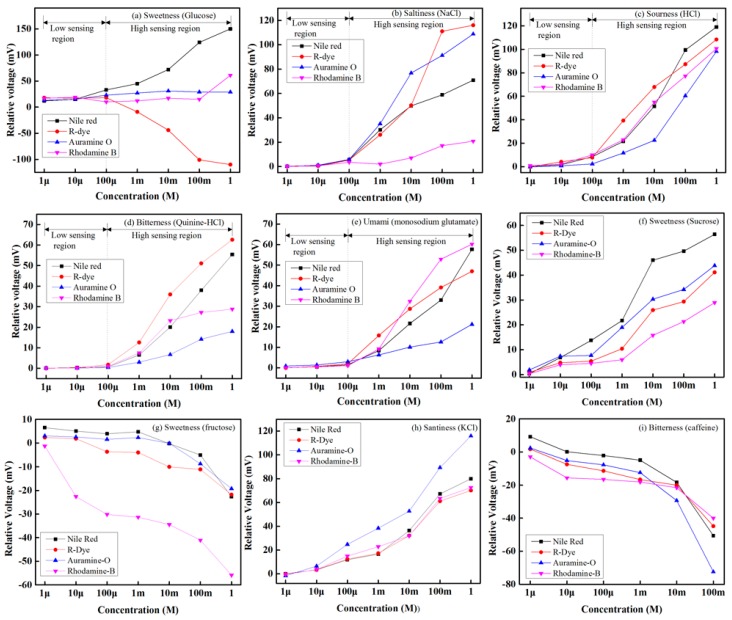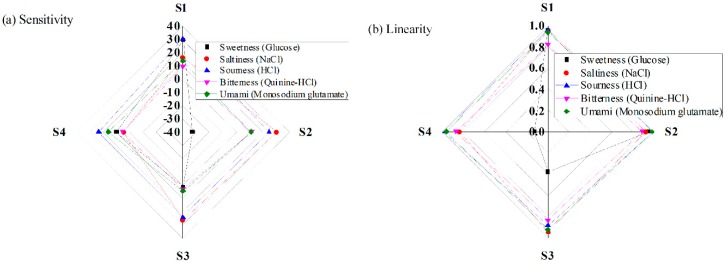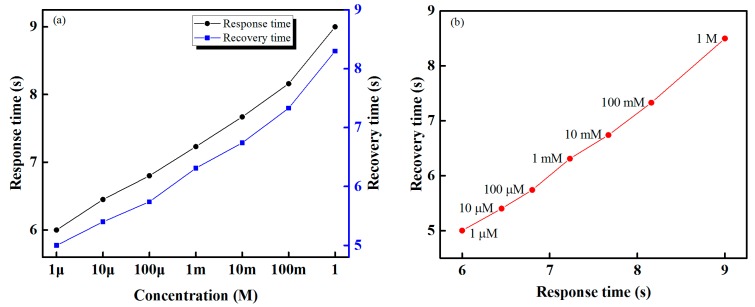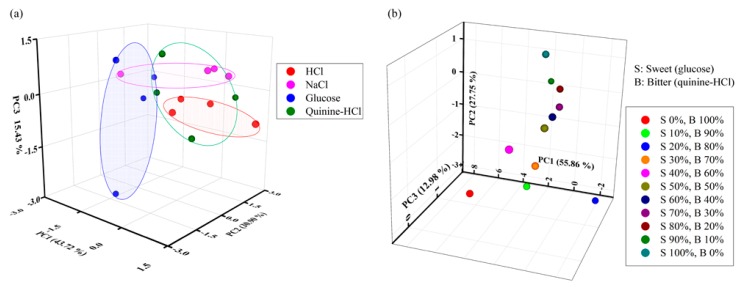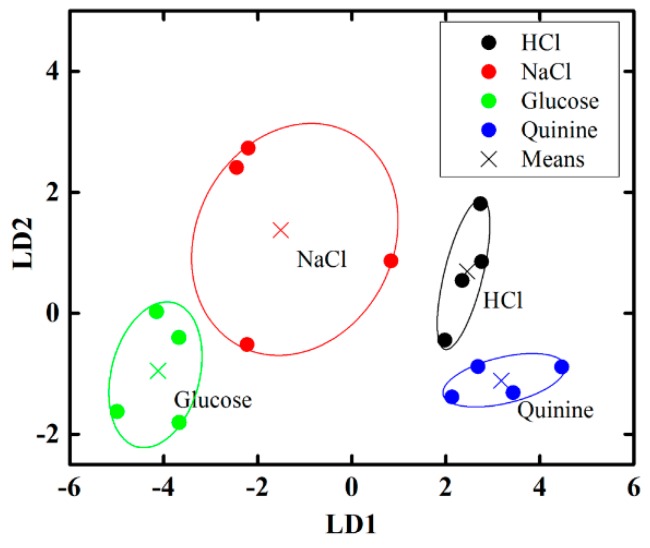Abstract
In this paper, an electronic tongue/taste sensor array containing different interdigitated capacitor (IDC) sensing elements to detect different types of tastes, such as sweetness (glucose), saltiness (NaCl), sourness (HCl), bitterness (quinine-HCl), and umami (monosodium glutamate) is proposed. We present for the first time an IDC electronic tongue using sensing membranes containing solvatochromic dyes. The proposed highly sensitive (30.64 mV/decade sensitivity) IDC electronic tongue has fast response and recovery times of about 6 s and 5 s, respectively, with extremely stable responses, and is capable of linear sensing performance (R2 ≈ 0.985 correlation coefficient) over the wide dynamic range of 1 µM to 1 M. The designed IDC electronic tongue offers excellent reproducibility, with a relative standard deviation (RSD) of about 0.029. The proposed device was found to have better sensing performance than potentiometric-, cascoded compatible lateral bipolar transistor (C-CLBT)-, Electronic Tongue (SA402)-, and fiber-optic-based taste sensing systems in what concerns dynamic range width, response time, sensitivity, and linearity. Finally, we applied principal component analysis (PCA) to distinguish between various kinds of taste in mixed taste compounds.
Keywords: electronic tongue, interdigitated capacitor, solvatochromic dye, sensing membrane, sensing element, dielectric constant, response time
1. Introduction
An electronic tongue/taste sensor array is a smart/intelligent instrument with an appropriate pattern recognition system, which can detect different types of taste from simple or complex mixtures of soluble nonvolatile molecules in a sample [1]. Taste sensors have huge applications in research institutes, pharmaceutical industries, food and beverage industries, medical diagnostic centers, environmental monitoring centers, and the agricultural sector [2,3,4,5,6,7,8,9].
Several different measuring/detecting techniques have been proposed in the literature for developing electronic tongues, such as voltammetry [10,11,12,13,14,15,16,17,18], amperometry [19,20], and potentiometry [21,22,23,24].
A disposable multichannel screen-printed lipid-based taste sensor was proposed by Sim et al., to control the quality of milk [25]. The advantages of this taste sensor are its small size, simple construction, and low cost, however, it has a response time of approximately 60 s. Thete et al. developed an optochemical fluorometric microspot array to detect various kinds of alcoholic beverages [26]. The main features of this sensor array include being disposable and having low fabrication cost, but its sensing mechanism is complex, and the sensor is bulky. Jeong Hyun-Min et al. developed a Cascoded Compatible Lateral Bipolar Transistor (C-CLBT) taste sensor with a lipid/polymer membrane as a sensing membrane; the sensor was operated in a MOSFET/BJT hybrid-mode. This sensor has the advantage of presenting a linear response, but it also has several disadvantages such as the need for an external electrode (making the sensor bulky), and a low sensitivity with very low dynamic range (1 fM to 1 mM), which stops it from matching the human taste threshold level [27].
An electronic tongue to detect various tastes using a surface acoustic wave [28] was proposed by Sehra et al. The operation and construction of this electronic tongue is simple, but the main disadvantage is its lack of selectivity. A fiber-optic multichannel taste sensor based on the evanescent wave absorption principle was developed by Lee et al. [29]. The developed sensor can detect five basic tastes with high sensitivity, is easy to fabricate, and it has a response time of approximately 10 s; however, it also has various demerits, such as short dynamic range, poor reproducibility and reliability issues. Sohna et al. proposed an electronic tongue using polymer beads in a microfluidic channel, to make a capillary-based tongue [30]. Their proposed electronic tongue has several advantages: low cost, small size, and real-time response. It also has various shortcomings, such as a complicated fabrication procedure, the need for a light source, and a charge-coupled device.
Much research has been directed to the use of interdigitated electrode (IDE) structures in a vast number of applications, such as biosensors [31,32,33,34,35,36,37], dielectric studies on thin films [38], gas sensors [39,40,41], pH sensors [42], bacteria detection [43], medical applications [44], optically-controlled microwave devices [45], humidity [46,47,48,49,50,51], pressure sensors [52], tunable devices [53], and chemical sensors [54].
An impedance spectroscopy taste sensor using gold interdigitated electrodes (IDEs) was developed by Riul et al. [55], with a composition of different chemical materials in an ultrathin membrane form deposited onto an IDE. The merits of this developed taste sensor are that the sensing units do not need any electroactive materials, and that it does not need a reference electrode. The impedance measuring mechanism of the sensor is, however, based on a complicated sensing instrument, with the impedance being observed by changing the frequency of a signal employed in the sensor’s electrode terminal.
We propose a highly sensitive interdigitated capacitor (IDC) electronic tongue with wide dynamic range, fast response and recovery time, low-cost, and high stability, to detect several kinds of taste, for example sweetness (glucose), saltiness (NaCl), sourness (HCl), bitterness (quinine-HCl), and umami (monosodium glutamate). The proposed electronic tongue has four IDC sensing elements. Four different kinds of solvatochromic dye (Nile red, Auramine O, Reichardt’s dye (R-dye), and Rhodamine B) were separately mixed with polyvinyl chloride (PVC) polymer and a N,N-dimethylacetamide (DMAC) solution, to prepare four different kinds of dielectric/sensing solutions. These four dielectric solutions were separately deposited into IDEs using a spin coater, to make the four different types of IDC taste sensing elements of the array. We believe this is the first time that an IDC taste sensor array/electronic tongue using a solvatochromic-dye based sensing membrane is reported. The proposed solvatochromic-dye based IDC taste sensor array/electronic tongue operates on a capacitance variation principle. When the IDC sensing elements of the electronic tongue is dipped into the taste-solution, the sensing membrane dielectric constant changes because of the charge transfer character of the solvatochromic dye molecules in it; this change in the sensing membrane’s dielectric constant modifies the IDC capacitance, which will then originate a variation in the received sensing signal’s amplitude. A data acquisition (DAQ) module was used to collect information from each channel of the IDC sensor array. We developed a LabVIEW program to collect the taste information from the array, and save the sensing information in an associated computer. The proposed IDC electronic tongue has other advantages, including real time monitoring capability, high reproducibility, and linear sensing performance. We applied an easy and very efficient data processing method, principal component analysis (PCA), to discriminate various tastes from a mixed set of taste samples, and obtained excellent performance.
2. Theory and Principle of Operation of the Electronic Tongue System
2.1. Electronic Tongue System Analogy
Sensory evaluation of palatable foods is more than a mere question of taste. It is also influenced by different kinds of other human senses such as sight, smell, touch, and hearing; this is illustrated in Figure 1. The notion of taste includes five basic qualities: sweetness, saltiness, sourness, bitterness, and umami. The Japanese term umami is used for “palatability”, a savory sensation caused by the monosodium glutamate (MSG) contained in disodium guanylate in mushrooms, seaweeds, and disodium inosinate in fish and meat [56,57,58]. Different chemical compounds characterize the different types of basic taste, and are tabulated in Table 1.
Figure 1.
Quantification of food palatability.
Table 1.
Chemical compounds for taste appreciation categorization.
| Taste | Chemical Compounds |
|---|---|
| Sweet | Sugar, fructose, saccharin, sucrose, glucose, few amino acids, l-alanine, alcohols. |
| Salt | Metal ions (inorganic salts) : NaCl, KCl, KNO3 |
| Sour | Acids (detachment of H+ in solution): HCl, H2SO4, CH3COOH, etc. |
| Bitter | Alkaloids (nicotine, quinine, caffeine) and non-alkaloids (aspirin), MgCl2, urea, l-tryptophan, etc. |
| Umami | Amino acids (glutamate) |
When addressing the issue of food taste detection, analogies can be set up within the biological taste sensing system as well as the electronic taste sensing system, insofar as several approximations can be establish in their operating principles and structure; these analogies are presented in Table 2 and Figure 2.
Table 2.
Three levels of analogy between human and electronic tongue taste recognition mechanisms.
| No. of Stage | Processing Level | Name of the Sensing Mechanism | |
|---|---|---|---|
| Humans Tongue | Electronic Tongue | ||
| 1 | Receptor level | Buds | Membranes of the sensing elements |
| 2 | Circuit level | Neural transmission | Transducer |
| 3 | Perceptual level | Cognition in the thalamus | Computer as well as statistical analysis |
Figure 2.
Functional analogy within the human (biological) taste sensing system and the electronic taste sensing system.
The surface of the human tongue has many small projections (known as papillae), inside which the taste buds are located. Taste buds are flask-like in shape, consisting of 50–100 individual taste cells joined together in a spherical structure. At the opposite end, taste cells are connected with a network of nerve fibers.
The human/biological tongue offers different sensitivities at different regions: the tip of the tongue is most sensitive to sweetness and saltiness, the sensation of sourness is best sensed on the lateral sides of the tongue, and the maximal sensitivity to bitterness appears on the back of the tongue. To feel the taste of food, the taste pores in the oral cavity absorb the chemicals of food. The taste cells in the taste buds collect these chemical stimuli and create nerve impulses. The taste impulses from the tongue are first transferred to specialized cells in the brain stem by two nerves (the facial nerve and the glossopharyngeal nerve) for initial processing. The taste impulses then ascend to the thalamus. After further analysis in the thalamus [59,60], the taste information is relayed to the part of the cerebral cortex that intervenes in the conscious appreciation of taste. The sensorial information about temperature and texture from the tongue triggers also a cortex response [61].
In the case of an electronic tongue, the sensor array consists of different sensing elements. Each sensing element has maximal sensing abilities for a particular taste, even though it can also respond slightly to other different tastes. When the taste molecules/chemicals react with the taste sensitive membranes of the sensing elements, the membranes’ electrical properties change, altering the received sensing signal. The electrical signals from various sensing elements of the array are transferred into the signal processing unit. After being processed in the data acquisition/signal processing unit, the converted signals are transferred into the data processing unit. This unit is an important part of the electronic tongue system; each one of the several sensing elements of the array generates a complicated response in a multi-component environment. Therefore, a relevant multidimensional data processing unit is needed; various pattern recognition methods have been applied for this purpose, such as PCA, Artificial Neural Networks (ANN), Partial Least Squares (PLS), and several others [62,63,64,65,66,67,68,69,70]. These pattern recognition methods aim to recognize the sensed taste, categorize between different kinds of tastes, and classify tastes into given sets.
2.2. Theoretical and Mathematical Formulation of the Proposed IDC Electronic Tongue
An interdigitated capacitor (IDC) is constituted by a special type of electrodes designed in a finger/comb shape with a periodic interlocking pattern and deposited on a substrate; these electrodes are then covered with a dielectric film, as shown in Figure 3. We applied an AC voltage v at two terminals of IDC to produce an electric field within the electrodes. The electric field flux lines then penetrate the dielectric, from the positive electrode to the negative one. The unit cell capacitance per length of an interdigitated electrode with an isotropic dielectric film material is given by [71]:
| (1) |
where is the absolute and is the relative dielectric constants of the sensing membrane. S is the space between two adjacent fingers of the IDE, t is the electrode thickness, and λ is the spatial wavelength.
Figure 3.
Schematic diagram of the interdigitated electrode: (a) without the dielectric/sensing membrane; (b) dielectric/sensing membrane in the IDE; and (c) cross-sectional view of the IDC.
The spatial wavelength λ is defined as [72,73]:
| (2) |
where W is the width of the electrode.
The total IDC capacitance can be calculated by:
| (3) |
where N is the number of fingers of the IDE, and L is their length. The parameter represents the elliptic integral of the first kind of modulus . The modulus is defined as:
| (4) |
Therefore, from Equations (2) and (4) we get:
| (5) |
where:
| (6) |
The peak value of the voltage across the IDC sensing element () can be written as follows:
| (7) |
where is the peak value of the current flowing through the IDC sensing element of the array and f is the signal frequency. The change in the IDC sensing element’s voltage due to the change in the taste solution’s concentration (and the resulting vary in the IDC capacitance) can thus be written as:
| (8) |
3. Experimental Work
3.1. Fabrication Procedure of the Interdigitated Electrode
We prepared the interdigitated electrode (IDE) with 40 pairs of fingers by vacuum evaporation and an electroplating deposition process on a 4 × 2 cm polyimide (PI) substrate with a thickness of approximately 22 µm. First, we deposited thin Cr and Cu layers (approximately 10 nm and 15 nm thick, respectively) on the PI substrate by vacuum evaporation. Then we transferred the photo mask of the IDE pattern onto the deposited metal layer and etched the unmasked patterned with a chemical etchant, to obtain the thin IDE fingers on the PI substrate. We then used a Cu electroplating process to increase the thickness of the Cu electrodes. Finally, a thin Sn layer was deposited on the thick Cu electrodes, and the residual PI substrate was cut. The step-by-step preparation procedure of the IDE is illustrated in detail in Figure 4. A scanning electron microscope (SEM) (S-4800, Hitachi, Ibaraki, Japan) was used to determine the IDE thickness, the finger’s width, and the widths of the gaps between fingers; values of approximately 22 μm, 100 μm and 100 μm were obtained, respectively.
Figure 4.
Preparation procedure of the IDE: (a) polyimide substrate; (b) thin Cr layer on the polyimide substrate; (c) depositing a thin Cu layer on the Cr layer; (d) photoresist layer, (e) transferring the mask pattern onto the photoresist layer; (f) etching the unmasked metal layers; (g) depositing the thick Cu layer onto the thin patterned Cu layer via electroplating; (h) depositing the thin Sn layer onto the thick patterned Cu layer; (i) cutting the residual polyimide substrate; and (j) SEM image of the surface of the interdigitated electrode (IDE).
3.2. Fabrication Procedure of Interdigitated Capacitor (IDC) Sensing Elements
The capability of a chemical compound to change color due to variations in the polarity of a solvent is defined as solvatochromism. Solvatochromism can be positive or negative [74,75]; a dye with solvatochromic properties is called a solvatochromic dye. In our experiments, we used a sensing/dielectric membrane containing a solvatochromic dye, to form the array of IDC sensing elements. In our experiment, we used four different IDC sensing elements in the array. To make these four different sensing elements, we selected four different types of solvatochromic dyes (Nile red [76,77], R-dye [78], Auramine O [79], and Rhodamine B [80,81]), a polymer (PVC), and DMAC as solvent. We bought all chemicals from the Sigma-Aldrich Chemical Corporation (Seoul, South Korea) and used them without any purification.
Four different types of sensing/dielectric solution in denser liquid form were prepared, and placed individually onto the IDE, thus making the IDC sensing elements of the array. Table 3 shows the chemical composition of four different sensing/dielectric solutions for the IDC sensing elements (S1 to S4) of the electronic tongue. The four types of sensing solutions were prepared with the following process: First, 0.014 g of every solvatochromic-dye was separately mixed into 8 mL of DMAC and sonicated for 10 min to prepare a dye-solution. Then, 0.056 g of PVC was mixed into dye-solution and sonicated for 10 min, to get the final sensing/dielectric solution for the IDC. To properly wash the IDE we used acetone, methanol, and deionized (DI) water, respectively; the IDE was then dried with N2 gas. After that, we deposited the sensing solution into the IDE with a spin coater, and dried the IDC at room temperature. This step-by-step fabrication process is shown in Figure 5.
Table 3.
Composition of the sensing/dielectric solution for the different sensing elements.
| Sensor ID | Solvatochromic Dye | Polymer | Solvent |
|---|---|---|---|
| S1 | Nile-red | PVC | DMAC |
| S2 | Reichardt’s dye (R-dye) | PVC | DMAC |
| S3 | Auramine O | PVC | DMAC |
| S4 | Rhodamine B | PVC | DMAC |
Figure 5.
Deposition process of the sensing/dielectric solution into the IDE with a spin coater, to obtain the IDC.
3.3. Detection Mechanism of the Proposed IDC Electronic Tongue
Figure 6 shows a schematic diagram of the designed IDC electronic tongue’s experimental setup. This setup involves three units: a signal generator unit, a taste signal detection unit, and a signal processing unit. The signal generator unit is a 500 kHz sine wave oscillator, whose output is linked to the input of a four channel buffer amplifier (to avoid loading effects). The four outputs of the buffer amplifier are linked to the inputs of four controllable current generators. The taste detection unit consists of four IDC sensing elements and a test chamber made of Teflon, to prevent reactions between the target taste solution and the test chamber. The four inputs of the IDC sensing elements are connected to the outputs of the four current sources.
Figure 6.
Schematic diagram of the proposed electronic tongue’s experimental setup.
When a voltage is applied across the IDC sensing element of the array, an electric field is generated that penetrates the dielectric/sensing material. If the taste solution’s concentration changes, then the dielectric constant of the IDC sensing elements will change accordingly, and as a result the output voltage of each IDC sensing element of the array will also change. The outputs of the IDC sensor array are connected to the inputs of the signal processing unit, which consists of a buffer amplifier, a voltage amplifier, and a peak detector [82,83,84,85]. The signals received from the sensor array are first fed to the high input impedance buffer amplifier, and afterwards to the voltage amplifier, for adequate voltage amplification. The peak detectors are used to convert the amplified received ac sensing signals to dc voltages; their outputs are connected to the DAQ module inputs. In our experiment, we used five different kinds of taste: sweetness (glucose), saltiness (NaCl), sourness (HCl), bitterness (quinine-HCl), and umami (monosodium glutamate). Different types of taste substances were individually mixed with DI water to get the desired concentrations of the five taste solutions (1 µM to 1 M). The IDC sensor array was vertically installed into the test container. During measurement, we closed the outlet valve and slowly injected approximately 15 mL of the target (taste or reference) solution into the test chamber with a syringe, using the inlet port. After measuring the concentration of the taste solution, we opened the out port to remove the taste solution from the test chamber and clean the container.
The principle of operation of the designed sensor array is based on capacitance variations. As discussed, when the IDC taste sensor array contacts the taste solution, the sensing membrane’s dielectric constant of the IDC sensing element change, thus changing the IDC capacitance. As a result, the voltage across the IDC and, hence, the output voltage of the peak detector change as well. At first, we injected DI water into the test container to get a reference voltage; the target taste solution was then injected, to obtain the corresponding sensing voltage; the difference between those two voltages is defined as the relative voltage (ΔV) of that particular taste solution. The DAQ module was interfaced with the signal processing unit and the computer to collect sensing information from the array and store the collected data in the computer for further processing.
4. Results and Discussion
Figure 7a shows the relationship between the speed of the spin coater and the thickness of the dielectric/sensing IDC membrane. As shown, the thickness of sensing membrane is inversely proportional to the speed of the spin coater, and decreases linearly when the speed increases. To optimize the dielectric/sensing membrane thickness, i.e., to find out the specific thickness of the dielectric membrane at which the IDC sensing element offers a maximum relative voltage, we used different thicknesses for this membrane, and measured the relative voltages obtained. The experimental results show that a 22-µm thickness produces the highest relative voltage. Therefore, in our experiment we used sensing membranes with approximately 22 µm, corresponding to a spin coater speed of 1000 rpm. The effect on the relative voltage of a change in the sensing membrane thickness is shown in Figure 7b. Figure 8 shows SEM images of various IDC dielectric/sensing membrane thicknesses.
Figure 7.
Characteristics of the sensing membrane: (a) relationship between the spin coater speed and the thickness of the IDC dielectric membrane; and (b) relationship between the thickness of the IDC dielectric membrane of the IDC and the obtained relative voltage.
Figure 8.
SEM images of different IDC dielectric/sensing membrane thicknesses: (a) 30.7 µm; (b) 26.6 µm; (c) 22.0 µm; (d) 15.6 µm; and (e) 10.7 µm.
The capacitance, phase shift, and capacitive impedance of the develop IDCs are functions of the taste solution’s concentration. Figure 9a presents the waveforms of the sensing and reference signal when no taste solution is in the test container. As shown, there are no differences in phase shift or in amplitudes in the sensing as well as the reference signals. When we inject a 1 mM glucose (taste) solution into the test container, a phase difference/shift within the sensing signal as well as the reference signal occurs. We used an oscilloscope (TDS3032B, Tektronix, Wilsonville, OR, USA) to measure the phase difference within the signals, and show the resulting waveforms in Figure 9b; the phase difference within the reference and a sensing signal at 1 mM glucose concentration is 9.4383 ns. These waveforms also confirm that the signal processing unit of the designed electronic tongue has sufficient performance to detect little differences in both the amplitude of a received sensing signal and phase difference/shift.
Figure 9.
Waveform response of the designed electronic tongue: (a) response with reference solution (DI water) and (b) response with taste (glucose) solution.
Figure 10a shows the phase shift within the sensing signal and the reference signal at glucose concentrations ranging from 1 μM to 1 M. As is readily apparent from this figure, the phase difference/shift within the two signals increases linearly with the increase in glucose concentration. The variation of capacitance with respect to the concentration of glucose/taste solution is shown in Figure 10b.
Figure 10.
Behavior of the sensing element of the designed electronic tongue for various concentrations of glucose: (a) phase shift and (b) capacitance.
We individually injected various taste solutions—sweetness (glucose), saltiness (NaCl), sourness (HCl), bitterness (quinine-HCl), and umami (monosodium glutamate)—with different concentrations of 1 μM to 1 M into the test container, at room temperature, to see the sensing response of every sensing element of the electronic tongue. The obtained results for all four sensing elements of the array (electronic tongue) are shown in Figure 11 for five different taste solutions.
Figure 11.
Sensing response of the designed IDC sensing elements for various tastes and concentrations: (a) sweetness (glucose); (b) saltiness (NaCl); (c) sourness (HCl); (d) bitterness (quinine-HCl), (e) umami (monosodium glutamate); (f) sweetness (sucrose), (g) sweetness (fructose); (h) saltiness (KCl); and (i) bitterness (caffeine).
The relative voltage of each sensing element is considered to be the response of that specific sensing element of the array. As shown in this figure, the relative voltage rises as the taste solution’s concentration rises. We divided the sensing performance of the array into two regions: the low and high sensing regions. The low sensing region covers concentrations from 1 µM to 100 µM, while the high sensing region covers concentration values of 100 µM to 1 M. As can be seen in Figure 11, every sensing element of the array provided a linear response over its dynamic range. In our study, we obtained that the highest detection performance was consistently achieved with sweetness (glucose solution), while the lowest detection performance was consistently obtained for bitterness (quinine-HCl). The relative voltages of glucose and bitterness at a concentration of 1 M were approximately 150 mV and 18 mV, respectively. We also observe the sensing ability of the proposed electronic tongue under other basic taste solutions, namely: sucrose and fructose for sweet sensation, KCl for salty sensation, and caffeine for bitterness sensation and the results are shown in Figure 11f–i, respectively.
The radar chart depicted in Figure 12a shows the sensitivity performances of the four IDC taste sensing elements (S1 to S4) under various taste solutions: sweetness, saltiness, sourness, bitterness, and umami. As shown, the first IDC sensing element S1 (which contains the Nile red sensing/dielectric membrane) presents higher sensitivity for sweetness (glucose) and sourness (HCl); the second sensing element S2 (which contains the R-dye dielectric membrane) offers higher sensitivities for saltiness (NaCl) and bitterness (quinine-HCl); the Rhodamine B sensing element S4 shows high sensitivity for umami (monosodium glutamate) only, and the sensing element S3 (Auramine O sensing membrane) shows low sensitivities for most of the taste solutions: sweetness, saltiness, bitterness, and umami. The highest sensitivities of the designed electronic tongue for sweetness, saltiness, sourness, bitterness, and umami are approximately 29.4, 30.64, 29.88, 11.56, and 16.19 mV/decade, respectively.
Figure 12.
Performance of the designed IDC taste sensor array for various taste solutions: (a) sensitivity; and (b) linearity.
We considered the sensitivity and linearity performance of the proposed IDC sensor array at the high sensing region (100 µM–1 M) because the human taste threshold levels are mostly within this range; the threshold levels for sweetness, saltiness, sourness, bitterness, and umami are 0.01 M, 0.01 M, 0.0009 M, 0.000008 M, and 0.0007 M, respectively [86]. From the above-presented results, we can therefore tell that the developed electronic tongue can cover the threshold levels of human taste.
The linearity of the designed IDC sensor array/ electronic tongue system under various kinds of tastes is shown in Figure 12b; on the dynamic range of the high sensing region (100 µM–1 M), the designed sensing system offers the highest degree of linearity in the response to the HCl solution, with an R2 value of approximately 0.985 for the R-dye sensing membrane, and the least linear response appears in the Rhodamine B sensing element when measuring the glucose solution.
To determine the reproducibility response of the designed IDC sensing element of the electronic tongue, we fabricated three samples of IDC sensing elements which contained R-dye sensing membrane. Then we measured the sensing performance of those IDC sensing elements under 1 mM of HCl solution and observe that all three show almost the same sensing response. Therefore, we say that the proposed IDC sensing elements have better reproducibility and the relative standard deviation (RSD) was approximately 0.029.
The response and recovery times of the developed IDC electronic tongue is shown in Figure 13. The designed sensing system offers rapid response and recovery times of approximately 6 s and 5 s, respectively; as we can see from Figure 13a, the response and recovery times increase as the taste solution’s concentration increases. Figure 13b shows a plot of response times versus recovery times for the designed IDC electronic tongue/taste sensor array for HCl concentrations in the range 1 μM to 1 M; as shown, response times are proportional to recovery times.
Figure 13.
Sensing performance of the designed IDC electronic tongue for different concentrations of HCl: (a) response and recovery times and (b) response times versus recovery times.
A simple and efficient multivariate data analysis method (PCA) has been applied for pattern recognition in our experiments. PCA derives a new set of coordinates, ordered by the data variance along those coordinates. It therefore allows a reduction in the number of dimensions of experimental data. Without major information loss, we can consider only the first few new principal coordinates, because they will contain the majority of the data variance. In this way, multi-dimensional data can be mapped onto only two or three axes.
In our experiment, we collected the highest relative amplitudes of every array sensing element for five cycles, and constructed an m × n data matrix for PCA, where m = 15 is the number of observations and n = 4 is the number of sensing elements. The score plot of the three-dimensional PCA derived principal axis (PC1–PC2–PC3) for sensing discrimination of four different tastes by the developed IDC-electronic tongue is shown in Figure 14a. As shown, the designed IDC taste sensor array/electronic tongue can successfully distinguish various types of tastes from the sensing performance of four sensing elements of the array. To better observe the distinguishing power of the sensor array, we classified the four distinct tastes in the same ellipse and found that PC1 can interpret 43.72% of the variance, whereas PC2 and PC3 can interpret 30.90% and 15.43% of the variance, respectively. Therefore, the overall cumulative variance coverage given by PC1, PC2 and PC3 is 90.05%. From the results shown in Figure 14a, we conclude that the designed IDC-taste sensor array is efficient in successfully distinguishing various kinds of tastes from mixed taste solutions.
Figure 14.
PCA results for the dataset obtained by sensing mixed taste solutions with the designed IDC electronic tongue: (a) mixture of four different taste solutions (HCl, NaCl, glucose, and quinine-HCl) and (b) different percentages of mixed glucose and quinine-HCl solutions.
To determine the discrimination performance of the proposed electronic tongue under the mixture of sweet (glucose) and bitter (quinine) compound with different percentages, we applied PCA method and the result is shown in Figure 14b, where it is observed that the electronic tongue can successfully distinguish mixed glucose and quinine solutions of different percentages. In our study, we also have applied the linear discriminant analysis (LDA) method to observe the discrimination performance of the proposed electronic tongue under the mixture of several taste compound such as: HCl, NaCl, glucose, and quinine and the result is shown in Figure 15. According to our analysis we can say that the discrimination performance of the proposed IDC electronic tongue is good and it can differentiate different types of taste from mixtures of different basic taste solutions.
Figure 15.
LDA results for the dataset obtained by sensing mixed taste (HCl, NaCl, glucose, and quinine-HCl) solutions with the proposed IDC electronic tongue.
Electronic tongues as well as bioelectronic tongues are hot research topics at the present time [87,88,89]. In [88,89], the authors proposed a bioelectronic tongue to observe taste sensing performance. In their work they fed the taste compound to a rat and collected the taste information from the rat’s gustatory cortex. To do this they inserted a microelectrode array in the rat’s gustatory cortex and coupled the array with the neural network and the array was connected with a signal processor as well as a computer to display taste information. They observed the taste information by collecting signal from the nerves. Though their research is interesting, the detection process is complex and expensive. In our present work, we propose an IDC-based electronic tongue which can directly detect any basic taste as well as complex mixtures of taste substances and display the taste information on a computer monitor. In addition, our sensing system does not need to interface with neurons, which make our sensing system simple in construction and less expensive. We previously proposed a lipid-based IDC taste sensing system to detect different types of tastes [90]. The sensing performance of the lipid-based IDC taste sensing system was good. It featured a multichannel design where each channel has a different lipid containing sensing membrane. Therefore, the lipid-based IDC taste sensing system could simultaneously collect taste information from all sensing elements of the array for a given concentration of the taste solution. The response as well as recovery time were approximately 12.92 s and 13.3 s, respectively. In [91], we reported for the first time an IDC-based glucose biosensing system which had a sensing/dielectric membrane containing a solvatochromic dye. The glucose biosensing system had a single channel, and the proposed IDC glucose biosensing system has a faster sensing response than the lipid-based IDC taste sensing system and its response and recovery times were about 7 s and 5 s respectively. In our present work, we proposed an IDC electronic tongue/taste sensing system, where we used taste sensitive sensing membranes incorporating different solvatochromic dyes to make the IDC array sensing elements. This electronic tongue also has multichannel sensing ability, therefore the proposed electronic tongue could collect taste information at the same time from the all sensing elements. Moreover, the proposed electronic tongue offers a highly sensing response and its response time was about 6 s, which was much shorter than that of the proposed lipid-based IDC taste sensing system as well as shorter than that of the glucose biosensing system.
We also compared the response of the developed solvatochromic sensing membrane IDC electronic tongue/taste sensor with other different sensors, such as potentiometric [92], complementary metal-oxide-semiconductor compatible lateral bipolar transistors (C-CLBT) [27], commercial electronic tongues (SA402) [93,94], and optical fiber sensors [29], in what respects dynamic range width, sensitivity, linearity, reproducibility, and response time. The various sensors’ performances are tabulated in Table 4. As shown in this table, the overall performance of the proposed IDC electronic tongue/taste sensor array compares favorably to the mentioned taste sensors.
Table 4.
Summary of sensing performance for the different sensing systems.
| No. | Sensing System | Parameters | Ref. | ||||
|---|---|---|---|---|---|---|---|
| Dynamic Range Width | Sensitivity (Umami) | Linearity | Response Time | Reproducibility (RSD) | |||
| 1 | Proposed Electronic Tongue | 1 µM–1 M | 16.19 mV/decade | 0.985 | 6 s | 0.029 | This work |
| 2 | Potentiometry | 0.1 µM–100 mM | - | poor | > 6.45 min | - | [92] |
| 3 | C-CLBT | 1 fM–1 mM | 12.2 µA/decade | good | - | - | [27] |
| 4 | Electronic Tongue (SA402) | 1 µM–1 M | 13.0 mV/decade | - | 20 s | - | [93,94] |
| 5 | Optical Fiber | 0.1 µM–10 mM | - | - | 10 s | poor | [29] |
5. Conclusions
In this paper, for the first time, an interdigitated capacitor (IDC) taste sensor array containing solvatochromic dyes to detect five different kinds of tastes—sweetness, saltiness, sourness, bitterness, and umami—is proposed. Four types of solvatochromic dyes: Nile red, Auramine O, Reichardt’s dye (R-dye), and Rhodamine B, were separately mixed with the polyvinylchloride (PVC) and N,N-dimethylacetamide (DMAC) as solvent, to create four different types of dielectric/sensing solutions, which were then used in the IDC sensing elements. The taste detection system was based on a capacitance variation principle: the IDC capacitance changes due to changes in the concentration of taste solutions and, consequently, the received sensing signal’s amplitude changes as well. The proposed IDC electronic tongue has very short response and recovery times of approximately 6 and 5 s, respectively, and has a wide dynamic range. The sensing performance of the developed electronic tongue were found to be linear, with a 0.985 correlation coefficient (R2) and the system has high sensing abilities. The designed electronic tongue has many advantages, including low cost, simple construction, the capability to provide real time responses, highly stable sensing performance, and high reproducibility; the components for the required electronic circuitry are inexpensive, and are readily available from any local electronic component market. To observe the discrimination ability of the proposed electronic tongue, a statistical technique (principal component analysis) was applied, and it was found that the designed IDC electronic tongue could successfully classify various kinds of taste from data collected with the sensor array. In future studies, various sensing substances will be applied to increase the number of sensing elements in the array, and we also plan to design IDC-based electronic noses.
Acknowledgments
This study was supported by the BK21 Plus project funded by the Ministry of Education, Korea (21A20131600011).
Author Contributions
Md. Rajibur Rahaman Khan is the main author of the manuscript and research. He proposed the detection idea, designed the methodologies of the IDC electronic tongue/taste sensing system, performed the experiments, draw all schematic diagrams, wrote the text of the manuscript and revision of the manuscript. Alireza Khalilian contributed to prepare dielectric and sensing solution, he also performed experiments. Shin-Won Kang provided insightful comments and suggestions.
Conflicts of Interest
The authors declare no conflict of interest.
References
- 1.Ciosek P., Wróblewski W. Potentiometric electronic tongues for foodstuff and biosample recognition—An overview. Sensors. 2011;11:4688–4701. doi: 10.3390/s110504688. [DOI] [PMC free article] [PubMed] [Google Scholar]
- 2.Gallardo J., Alegret S., Del Valle M. Application of a potentiometric electronic tongue as a classification tool in food analysis. Talanta. 2005;66:1303–1309. doi: 10.1016/j.talanta.2005.01.049. [DOI] [PubMed] [Google Scholar]
- 3.Gutés A., Ibanez A.B., Del Valle M., Cespedes F. Automated SIA e-tongue employing a voltammetric biosensor array for the simultaneous determination of glucose and ascorbic acid. Electroanalysis. 2006;18:82–88. doi: 10.1002/elan.200503378. [DOI] [Google Scholar]
- 4.Hruškar M., Major N., Krpan M. Evaluation of milk and dairy products. Mljekarstvo. 2009;59:193–200. [Google Scholar]
- 5.Palit M., Tudu B., Dutta P.K., Dutta A., Jana A., Roy J.K., Bhattacharyya N., Bandyopadhyay R., Chatterjee A. Classification of black tea taste and correlation with tea taster’s mark using voltammetric electronic tongue. IEEE Trans. Instrum. Meas. 2010;59:2230–2239. doi: 10.1109/TIM.2009.2032883. [DOI] [Google Scholar]
- 6.Gutierrez M., Alegret S., Del Valle M. Potentiometric bioelectronic tongue for the analysis of urea and alkaline ions in clinical samples. Biosens. Bioelectron. 2007;22:2171–2178. doi: 10.1016/j.bios.2006.10.007. [DOI] [PubMed] [Google Scholar]
- 7.Esbensen K., Kirsanov D., Rudnitskaya A.L.A., Mortensen J., Pedersen J., Vognsen L., Makarychev-Mikhailov S., Vlasov Y. Fermentation monitoring using multisensor systems: Feasibility study of the electronic tongue. Anal. Bioanal. Chem. 2004;378:391–395. doi: 10.1007/s00216-003-2299-x. [DOI] [PubMed] [Google Scholar]
- 8.Wilson D., Abbas M.N., Radwan A.A.L., del Valle M. Potentiometric electronic tongue to resolve mixtures of sulfide and perchlorate anions. Sensors. 2011;11:3214–3226. doi: 10.3390/s110303214. [DOI] [PMC free article] [PubMed] [Google Scholar]
- 9.Gutiérrez M., Gutiérrez J.M., Alegret S., Leija L., Hernández P.R., Liliana Favari L., Muñoz R., Del Valle M. Remote environmental monitoring employing a potentiometric electronic tongue. Int. J. Environ. Anal. Chem. 2008;88:103–117. doi: 10.1080/03067310701441005. [DOI] [Google Scholar]
- 10.Bueno L., de Araujo W.R., Salles M.O., Kussuda M.Y., Paixão T.R.L.C. Voltammetric electronic tongue for discrimination of milk adulterated with urea, formaldehyde and melamine. Chemosensors. 2014;2:251–266. doi: 10.3390/chemosensors2040251. [DOI] [Google Scholar]
- 11.Winquist F., Olsson J., Eriksson M. Multicomponent analysis of drinking water by a voltammetric electronic tongue. Anal. Chim. Acta. 2011;683:192–197. doi: 10.1016/j.aca.2010.10.027. [DOI] [PubMed] [Google Scholar]
- 12.Winquist F. Voltammetric electronic tongues—basic principles and applications. Microchim. Acta. 2008;163:3–10. doi: 10.1007/s00604-007-0929-2. [DOI] [Google Scholar]
- 13.Cetό X., Apetrei C., Del Valle M., Rodriguez-Méndez M.L. Evaluation of red wines antioxidant capacity by means of a voltammetric e-tongue with an optimized sensor array. Electrochim. Acta. 2014;120:180–186. doi: 10.1016/j.electacta.2013.12.079. [DOI] [Google Scholar]
- 14.Garcia-Hernandez C., Medina-Plaza C., Garcia-Cabezon C., Martin-Pedrosa F., del Valle I., de Saja J.A., Rodríguez-Méndez M.L. An electrochemical quartz crystal microbalance multisensor system based on phthalocyanine nanostructured films: Discrimination of musts. Sensors. 2015;15:29233–29249. doi: 10.3390/s151129233. [DOI] [PMC free article] [PubMed] [Google Scholar]
- 15.Zeravik J., Hlavacek A., Lacina K., Skládal P. State of the art in the field of electronic and bioelectronic tongues—towards the analysis of wines. Electroanalysis. 2009;21:2509–2520. doi: 10.1002/elan.200900285. [DOI] [Google Scholar]
- 16.Xu Y., Zhang W., Shi J., Zou X., Li Z., Zhu Y. Microfabricated interdigitated Au electrode for voltammetric determination of lead and cadmium in Chinese mitten crab (Eriocheir sinensis) Food Chem. 2016;201:190–196. doi: 10.1016/j.foodchem.2016.01.078. [DOI] [PubMed] [Google Scholar]
- 17.Arrieta A., Rodriguez-Mendez M.L., de Saja J.A. Langmuir–blodgett film and carbon paste electrodes based on phthalocyanines as sensing units for taste. Sens. Aatctuors B Chem. 2003;95:357–365. doi: 10.1016/S0925-4005(03)00438-6. [DOI] [Google Scholar]
- 18.Parra V., Arrieta A., Fernández-Escudero J.A., Rodríguez-Méndez M.L., de Saja J.A. Electronic tongue based on chemically modified electrodes and voltammetry for the detection of adulterations in wines. Sens. Actuators B Chem. 2006;118:448–453. doi: 10.1016/j.snb.2006.04.043. [DOI] [Google Scholar]
- 19.Scampicchio M., Benedetti S., Brunetti B., Mannino S. Amperometric electronic tongue for the evaluation of the tea astringency. Electroanal. 2006;18:1643–1648. doi: 10.1002/elan.200603586. [DOI] [Google Scholar]
- 20.Scampicchio M., Ballabio D., Arecchi A., Cosio S.M., Mannino S. Amperometric electronic tongue for food analysis. Microchim. Acta. 2008;163:11–21. doi: 10.1007/s00604-008-0915-8. [DOI] [Google Scholar]
- 21.Bae Y.M., Cho S.I. Use of a polymer membrane sensor array for quantification and discrimination of liquid food. T. ASAE. 2005;48:251–256. doi: 10.13031/2013.17925. [DOI] [Google Scholar]
- 22.Halder A., Mahato M., Sinha T., Adhikari B., Mukherjee S., Bhattacharyya N. Polymer membrane electrode based potentiometric taste sensor: A new sensor to distinguish five basic tastes; Proceedings of the IEEE Conference on Sensing Technology; Kolkata, India. 18–21 December 2012; pp. 785–789. [Google Scholar]
- 23.Tahara Y., Nakashi K., Ji K., Ikeda A., Toko K. Development of a portable taste sensor with a lipid/polymer membrane. Sensors. 2013;13:1076–1084. doi: 10.3390/s130101076. [DOI] [PMC free article] [PubMed] [Google Scholar]
- 24.Tahara Y., Ikeda A., Maehara Y., Habara M., Toko K. Development and evaluation of a miniaturized taste sensor chip. Sensors. 2011;11:9878–9886. doi: 10.3390/s111009878. [DOI] [PMC free article] [PubMed] [Google Scholar]
- 25.Sim M.Y.M., Shya T.J., Ahmad M.N., Shakaff A.Y.M., Othman A.R., Hitam M.S. Monitoring of milk quality with disposable taste sensor. Sensors. 2003;3:340–349. doi: 10.3390/s30900340. [DOI] [Google Scholar]
- 26.Thete A.R., Henkel T., Göckeritz R., Endlich M., Köhler J.M., Gross G.A. A hydrogel based fluorescent micro array used for the characterization of liquid analytes. Anal. Chim. Acta. 2009;633:81–89. doi: 10.1016/j.aca.2008.11.030. [DOI] [PubMed] [Google Scholar]
- 27.Jeong H.M., Yun H.J., Kwon J.B., Kwon H.C., Kim S.W., Yoon N.R., Kim J.S., Kang S.W. Taste sensor based on lipid/polymer membrane using cascoded compatible lateral bipolar transistor. Sens. Lett. 2015;13:683–686. doi: 10.1166/sl.2015.3484. [DOI] [Google Scholar]
- 28.Sehra G., Cole M., Gardner J.W. Miniature taste sensing system based on dual SH-SAW sensor device: An electronic tongue. Sens. Actuators B Chem. 2004;103:233–239. doi: 10.1016/j.snb.2004.04.055. [DOI] [Google Scholar]
- 29.Lee S.M., Jang S.W., Lee S.H., Kim J.H., Kim S.H., Kang S.W. Measurement of basic taste substances by a fiber optic taste sensor using evanescent field absorption. Sens. Mater. 2002;14:11–21. [Google Scholar]
- 30.Sohna Y.S., Goodeyb A., Anslynb E.V., McDevittb J.T., Shearb J.B., Neikirka D.P. A microbead array chemical sensor using capillary-based sample introduction: Toward the development of an electronic tongue. Biosens. Bioelectron. 2005;21:303–312. doi: 10.1016/j.bios.2004.08.050. [DOI] [PubMed] [Google Scholar]
- 31.Jung H.W., Chang Y.W., Lee G.Y., Cho S., Kang M.J. A capacitive biosensor based on an interdigitated electrode with nanoislands. Anal. Chim. Acta. 2014;844:27–34. doi: 10.1016/j.aca.2014.07.006. [DOI] [PubMed] [Google Scholar]
- 32.Wang H., Wu X., Dong P., Wang C., Wang J., Liu Y., Chen J. Electrochemical biosensor based on interdigitated electrodes for determination of thyroid stimulating hormone. Int. J. Electrochem. Sci. 2014;9:12–21. [Google Scholar]
- 33.Quershi A., Gurbuz Y., Niazi J.H. A novel interdigitated capacitor based biosensor for detection of cardiovascular risk marker. Biosens. Bioelectron. 2009;25:877–882. doi: 10.1016/j.bios.2009.08.043. [DOI] [PubMed] [Google Scholar]
- 34.Patskovsky S., Latendresse V., Dallaire A.M., Doré-Mathieu L., Meunier M. Combined surface plasmon resonance and impedance spectroscopy systems for biosensing. Analyst. 2014;139:596–602. doi: 10.1039/C3AN01685D. [DOI] [PubMed] [Google Scholar]
- 35.Angkawisittpan N., Manasri T. Determination of sugar content in sugar solutions using interdigital capacitor sensor. Meas. Sci. Rev. 2012;12:8–13. doi: 10.2478/v10048-012-0002-0. [DOI] [Google Scholar]
- 36.Dubuc D., Grenier K., Poupo M., Fournié J.J. Broadband microwave biosensing based on interdigitated capacitor for lab-on-chip applications; Proceeding of the IEEE Conference on New Circuits and Systems; Montreal, QC, Canada. 17–20 June 2012; pp. 529–532. [Google Scholar]
- 37.Huang S.Y., Chou C.M., Chen T.H., Chiou P.C., Hsiao V.K.S., Ching C.T.S., Sun T.P. Enhanced sensitivity using microfluidic, interdigitated microelectrode based capacitance glucose sensor measured at 4 MHz. J. Electrochem. Soc. 2014;161:B102–B105. doi: 10.1149/2.001406jes. [DOI] [Google Scholar]
- 38.Kotani K., Kawayama I., Tonouchi M. Dielectric response of c-oriented SrBi2Ta2O9 thin films observed with interdigital electrodes. Jpn. J. Appl. Phys. 2002;41:6790–6792. doi: 10.1143/JJAP.41.6790. [DOI] [Google Scholar]
- 39.Kumara N., Sahatiyaa P., Dubeya P. Fabrication of CNT based gas sensor using interdigitated gold electrodes. Procedia Mater. Sci. 2014;6:1976–1980. doi: 10.1016/j.mspro.2014.07.232. [DOI] [Google Scholar]
- 40.Tsenga C.C., Chouc Y.H., Hsieh T.W., Wange M.W., Shub Y.Y., Ger M.D. Interdigitated electrode fabricated by integration of ink-jet printing with electroless plating and its application in gas sensor. Colloid. Surf. A. 2012;402:45–52. doi: 10.1016/j.colsurfa.2012.03.016. [DOI] [Google Scholar]
- 41.Sapsanis C., Omran H., Chernikova V., Shekhah O., Belmabkhout Y., Buttner U., Eddaoudi M., Salama K.N. Insights on capacitive interdigitated electrodes coated with MOF thin films humidity and VOCs sensing as a case study. Sensors. 2015;15:18153–18166. doi: 10.3390/s150818153. [DOI] [PMC free article] [PubMed] [Google Scholar]
- 42.Arshak K., Gill E., Arshak A., Korostynska O. Investigation of tin oxides as sensing layers in conductimetric interdigitated pH sensors. Sens. Actuators B Chem. 2007;127:42–53. doi: 10.1016/j.snb.2007.07.014. [DOI] [Google Scholar]
- 43.Lian Y., He F., Wang H., Tong F. A new aptamer/graphene interdigitated gold electrode piezoelectric sensor for rapid and specific detection of staphylococcus aureus. Biosens. Bioelectron. 2015;65:314–319. doi: 10.1016/j.bios.2014.10.017. [DOI] [PubMed] [Google Scholar]
- 44.Fok M., Bashir M., Fraser H., Strouther N., Mason A. A novel microwave sensor to detect specific biomarkers in human cerebrospinal fluid and their relationship to cellular ischemia during thoracoabdominal aortic aneurysm repair. J. Med. Syst. 2015;39:1–5. doi: 10.1007/s10916-015-0208-4. [DOI] [PubMed] [Google Scholar]
- 45.Iezekiel S. Microwave Photonics: Devices and Applications. John Wiley & Sons Ltd; West Sussex, UK: 2009. [Google Scholar]
- 46.Islam T., Nimal A.T., Mittal U., Sharma M.U. A micro interdigitated thin film metal oxide capacitive sensor for measuring moisture in the range of 175–625 ppm. Sens. Actuators B Chem. 2015;221:357–364. doi: 10.1016/j.snb.2015.06.101. [DOI] [Google Scholar]
- 47.Qu W., Wlodarski W. A thin-film sensing element for ozone, humidity and temperature. Sens. Actuators B Chem. 2000;64:42–48. doi: 10.1016/S0925-4005(99)00481-5. [DOI] [Google Scholar]
- 48.Rivadeneyra A., Fernández-Salmerón J., Banqueri J., López-Villanueva J., Capitan-Vallvey L.F., Palma A.J. A novel electrode structure compared with interdigitated electrodes as capacitive sensor. Sens. Actuators B Chem. 2014;204:552–560. doi: 10.1016/j.snb.2014.08.010. [DOI] [Google Scholar]
- 49.Steffens C., Manzoli A., Paschoalin R.T., Tiggemann L., Steffens J., Teixeira E., de Paula Herrmann P.S. Tracing paper substrate used for development of interdigitated graphite electrode and its application as humidity sensor. Synth. Met. 2013;183:36–39. doi: 10.1016/j.synthmet.2013.09.015. [DOI] [Google Scholar]
- 50.Islam T., Mittal U., Nimal A.T., Sharma M.U. A nanoporous thin-film miniature interdigitated capacitive impedance sensor for measuring humidity. Int. J. Smart Nano Mater. 2014;5:169–179. doi: 10.1080/19475411.2014.935833. [DOI] [Google Scholar]
- 51.Yang T., Yu Y.Z., Zhu L.S., Wu X., Wang X.H., Zhang J. Fabrication of silver interdigitated electrodes on polyimide films via surface modification and ion-exchange technique and its flexible humidity sensor application. Sens. Actuators B Chem. 2015;208:327–333. doi: 10.1016/j.snb.2014.11.043. [DOI] [Google Scholar]
- 52.Arshak K., Morris D., Arshak A., Korostynska O., Moorea E. PVB, PVAc and PS pressure sensors with interdigitated electrodes. Sens. Actuators A Phys. 2006;132:199–206. doi: 10.1016/j.sna.2006.02.018. [DOI] [Google Scholar]
- 53.Wu H.D., Zhang Z., Barnes F., Jackson C.M., Kain A., Cuchiaro J.D. Voltage tunable capacitors using high temperature superconductors and ferroelectrics. IEEE Trans. Appl. Supercond. 1994;4:156–160. [Google Scholar]
- 54.Korostynska O., Mason A., Al-Shamma A.L. Flexible microwave sensors for realtime analysis of water contaminants. J. Electromagn. Wave. 2013;27:2075–2089. doi: 10.1080/09205071.2013.832393. [DOI] [Google Scholar]
- 55.Riu A., Jr., dos Santos D.S., Jr., Wohnrath K., Di Tommazo R., Carvalho A.C.P.L.F., Fonseca F.J., Oliveira O.N., Jr., Taylor D.M., Mattoso L.H.C. Artificial taste sensor: efficient combination of sensors made from langmuir-blodgett films of conducting polymers and a ruthenium complex and self-assembled films of an azobenzene-containing polymer. Langmuir. 2002;18:239–245. [Google Scholar]
- 56.Pfaffmann C. Handbook of Physiology, Section 1, Neurophysiology. Volume 1. American Physiological Society; Washington, DC, USA: 1959. The sense of taste; p. 507. [Google Scholar]
- 57.Kawamura Y., Kare M.R. Umami: A Basic Taste: Physiology, Biochemistry, Nutrition, Food Science (Food Science and Technology) Marcel Dekker Inc.; New York, NY, USA: 1987. [Google Scholar]
- 58.Zheng J.Y., Keeney M.P. Taste masking analysis in pharmaceutical formulation development using an electronic tongue. Int. J. Pharm. 2006;310:118–124. doi: 10.1016/j.ijpharm.2005.11.046. [DOI] [PubMed] [Google Scholar]
- 59.Thalamus. [(accessed on 21 March 2016)]. Available online: https://www.boundless.com/physiology/textbooks/boundless-anatomy-and-physiology-textbook/the-central-nervous-system-cns-12/the-diencephalon-119/thalamus-645–9360/
- 60.Thalamus. [(accessed on 21 March 2016)]. Available online: https://en.wikipedia.org/wiki/Thalamus.
- 61.Gustatory and Olfactory Senses. [(accessed on 21 March 2016)]. Available online: http://michaeldmann.net/mann10.html.
- 62.Chang C.C., Saad B., Surif M., Ahmad M.N., Shakaff A.Y.M. Disposable e-tongue for the assessment of water quality in fish tanks. Sensors. 2008;8:3665–3677. doi: 10.3390/s8063665. [DOI] [PMC free article] [PubMed] [Google Scholar]
- 63.Kundu P.K., Kundu M.J. The e-tongue-based classification and authentication of mineral water samples using cross-correlation-based PCA and Sammon’s nonlinear mapping. J. Chemom. 2013;27:379–393. doi: 10.1002/cem.2521. [DOI] [Google Scholar]
- 64.Masnan M.J., Zakaria A., Shakaff A.Y.M., Mahat N.I., Hamid H., Subari N., Saleh J.M. Principal component analysis—A realization of classification success in multi sensor data fusion. [(accessed on 21 March 2016)]. Available online: http://cdn.intechopen.com/pdfs/30421.pdf.
- 65.Kalit M.T., Marković K., Kalit S., Vahčić N., Havranek J. Application of electronic nose and electronic tongue in the dairy industry. Mljekarstvo. 2014;64:228–244. doi: 10.15567/mljekarstvo.2014.0402. [DOI] [Google Scholar]
- 66.Moreno-Barón L., Cartas R., Merkoçi A., Alegret S., Gutiérrez J.M., Leija L., Hernandez P.R., Muñoz R., del Valle M. Data compression for a voltammetric electronic tongue modelled with artificial neural networks. Anal. Lett. 2005;38:2189–2206. doi: 10.1080/00032710500259342. [DOI] [Google Scholar]
- 67.Gil-Sánchez L., Garrigues J., Garcia-Breijo E., Grau R., Aliño M., Baigts D., Barat J.M. Artificial neural networks (Fuzzy ARTMAP) analysis of the data obtained with an electronic tongue applied to a ham-curing process with different salt formulations. Appl. Soft. Comput. 2015;30:421–429. doi: 10.1016/j.asoc.2014.12.037. [DOI] [Google Scholar]
- 68.Buratti S., Ballabio D., Benedetti S., Cosio M.S. Prediction of italian red wine sensorial descriptors from electronic nose, electronic tongue and spectrophotometric measurements by means of genetic algorithm regression models. Food Chem. 2007;100:211–218. doi: 10.1016/j.foodchem.2005.09.040. [DOI] [Google Scholar]
- 69.Liu R., Zhang X., Zhang L., Gao X., Li H., Shi J., Li X. Bitterness intensity prediction of berberine hydrochloride using an electronic tongue and a GA-BP neural network. Exp. Ther. Med. 2014;7:1696–1702. doi: 10.3892/etm.2014.1614. [DOI] [PMC free article] [PubMed] [Google Scholar]
- 70.Sipos L., Gere A., Szollosi D., Kovacs Z., Kokai Z., Fekete A. Sensory evaluation and electronic tongue for sensing flavored mineral water taste attributes. J. Food Sci. 2013;78:S1602–S1608. doi: 10.1111/1750-3841.12178. [DOI] [PubMed] [Google Scholar]
- 71.Abu-Abed A.S., Lindquist R.G. Capacitive interdigital sensor with inhomogeneous nematic liquid crystal film. Prog. Electromagn. Res. B. 2008;7:75–87. doi: 10.2528/PIERB08022901. [DOI] [Google Scholar]
- 72.Igreja R., Dias C.J. Analytical evaluation of the interdigital electrodes capacitance for a multi-layered structure. Sens. Actuators A Phys. 2004;112:291–301. doi: 10.1016/j.sna.2004.01.040. [DOI] [Google Scholar]
- 73.Igreja R., Dias C.J. Dielectric response of interdigital chemocapacitors: The role of the sensitive layer thickness. Sens. Actuators B Chem. 2006;115:69–78. doi: 10.1016/j.snb.2005.08.019. [DOI] [Google Scholar]
- 74.Reichardt C. Solvatochromic dyes as solvent polarity indicators. Chem. Rev. 1994;94:2319–2358. doi: 10.1021/cr00032a005. [DOI] [Google Scholar]
- 75.Marini A., Muñoz-Losa A., Biancardi A., Mennucci B. What is solvatochromism. J. Phys. Chem. B. 2010;114:17128–17135. doi: 10.1021/jp1097487. [DOI] [PubMed] [Google Scholar]
- 76.Fletcher K.A., Storey I.A., Hendricks A.E., Pandey S., Pandey S. Behavior of the solvatochromic probes Reichardt’s dye, pyrene, dansylamide, Nile red and 1-pyrenecarbaldehyde within the room-temperature ionic liquid bmimPF6. Green Chem. 2001;3:210–215. doi: 10.1039/b103592b. [DOI] [Google Scholar]
- 77.Deye J.F., Berger T.A., Anderson A.G. Nile red as a solvatochromic dye for measuring solvent strength in normal liquids and mixtures of normal liquids with supercritical and near critical fluids. Anal. Chem. 1990;62:615–622. doi: 10.1021/ac00205a015. [DOI] [Google Scholar]
- 78.Macquarrie D.J., Tavener S.J., Gray G.W., Heath P.A., Rafelt J.S., Saulzet S.I., Hardy J.J.E., Clark J.H., Sutra P., Brunel D., et al. The use of Reichardt’s dye as an indicator of surface polarity. New J. Chem. 1999;23:725–731. doi: 10.1039/a901563i. [DOI] [Google Scholar]
- 79.Rauf M.A., Hisaindee S. Studies on solvatochromic behavior of dyes using spectral techniques. J. Mol. Struct. 2013;1042:45–56. doi: 10.1016/j.molstruc.2013.03.050. [DOI] [Google Scholar]
- 80.Rosenthal I., Peretz P., Muszkat K.A. Thermochromic and hyperchromic effects in Rhodamine B solutions. Phys. Chem. 1979;83:350–353. doi: 10.1021/j100466a010. [DOI] [Google Scholar]
- 81.Hinckley D.A., Seybold P.G., Borris D.P. Solvatochromism and thermochromism of Rhodamine solutions. Spectrochim. Acta Mol. Biomol. Spectrosc. 1986;42:747–754. doi: 10.1016/0584-8539(86)80095-2. [DOI] [Google Scholar]
- 82.Khan Md.R.R., Kang B.H., Yeom S.H., Kwon D.H., Kang S.W. Fiber-optic pulse width modulation sensor for low concentration VOC gas. Sens. Actuators B Chem. 2013;188:689–696. doi: 10.1016/j.snb.2013.07.036. [DOI] [Google Scholar]
- 83.Khan Md.R.R., Kang S.W. A high sensitivity and wide dynamic range fiber-optic sensor for low-concentration VOC gas detection. Sensors. 2014;14:23321–23336. doi: 10.3390/s141223321. [DOI] [PMC free article] [PubMed] [Google Scholar]
- 84.Khan Md.R.R., Kang B.H., Lee S.W., Kim S.H., Yeom S.H., Lee S.H., Kang S.W. Fiber-optic multi-sensor array for detection of low concentration volatile organic compounds. Opt. Express. 2013;21:20119–20129. doi: 10.1364/OE.21.020119. [DOI] [PubMed] [Google Scholar]
- 85.Khan Md.R.R., Kang S.W. Highly sensitive fiber-optic volatile organic compound gas sensor using a solvatochromic-dye containing polymer waveguide based on pulse-width modulation technique. Sens. Lett. 2015;13:663–668. doi: 10.1166/sl.2015.3480. [DOI] [Google Scholar]
- 86.Bowen R. Physiology of Taste. [(accessed on 21 March 2016)]. Available online: http://www.vivo.colostate.edu/hbooks/pathphys/digestion/pregastric/taste.html.
- 87.Ha D., Sun Q., Su K., Wan H., Li H., Xu N., Sun F., Zhuang L., Hu N., Wang P. Recent achievements in electronic tongue and bioelectronic tongue as taste sensors. Sens. Actuators B Chem. 2015;207:1136–1146. doi: 10.1016/j.snb.2014.09.077. [DOI] [Google Scholar]
- 88.Qin Z., Zhang B., Hu L., Zhuang L., Hu N., Wang P. A novel bioelectronic tongue in vivo for highly sensitive bitterness detection with brain-machine interface. Biosens. Bioelectron. 2016;78:374–380. doi: 10.1016/j.bios.2015.11.078. [DOI] [PubMed] [Google Scholar]
- 89.Qin Z., Zhang B., Hu N., Wang P. Detection and classification of tastants in vivo using a novel bioelectronic tongue in combination with brain-machine interface; Proceedings of the 37th Annual International Conference of the IEEE Engineering in Medicine and Biology Society, IEEE Conference on Sensing Technology; Milan, Italy. 25–29 August 2015; pp. 7550–7553. [DOI] [PubMed] [Google Scholar]
- 90.Khan M.R.R., Kang S.W. Highly sensitive multi-channel IDC sensor array for low concentration taste detection. Sensors. 2015;15:13201–13221. doi: 10.3390/s150613201. [DOI] [PMC free article] [PubMed] [Google Scholar]
- 91.Khan M.R.R., Khalilian A., Kang S.W. Fast, highly-sensitive, and wide-dynamic-range interdigitated capacitor glucose biosensor using solvatochromic dye-containing sensing membrane. Sensors. 2016;16 doi: 10.3390/s16020265. [DOI] [PMC free article] [PubMed] [Google Scholar]
- 92.Majumdar S., Adhikari B. Taste sensing with polyacrylamide grafted cellulose. J. Sci. Ind. Res. India. 2006;65:237–243. [Google Scholar]
- 93.Verrelli G.M. Electronic Tongue Systems for Food and Environmental Applications. [(accessed on 21 March 2016)]. Available online: http://citeseerx.ist.psu.edu/viewdoc/download?doi=10.1.1.131.3110&rep=rep1&type=pdf.
- 94.Toko K. Biomimetic Sensor Technology. Cambridge University Press; Cambridge, UK: 2000. [Google Scholar]



